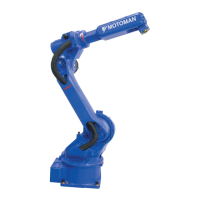5-5
168542-1CD
168542-1CD
MLX200 Software and
Operations
5 Collision Detection
5.2 Configuring Collision Detection from the HMI
After starting Measurement Mode, the [Start Measurement Mode] button
will be grayed out and the “CD Status” indicator on the right part of the
screen will update to display “Measurement Mode” as shown in Fig. 5-3.
While the application is executing, the numerical values under the
“Measured Max Torque Disturbance” will begin to automatically update.
These values usually become fairly stable after a few application cycles,
but it is recommended to run the cycle for 30-60 minutes to get reliable
data.
Fig. 5-3: Collision Detection in Measurement Mode
After measuring the torque disturbance values, press the [Stop
Measurement Mode] button and the CD Status should change back to
“Inactive”. The next step is to fill in the Allowable Max Torque Disturbance
values based on the measured values. This can be done either by
manually entering values into the numerical inputs under Allowable Max
Torque Disturbance or by using the [Copy Measured to Allowable with
Offset] button. In Fig. 5-4, this offset value is set to 10 and the Allowable
Disturbances are all then set to 10 higher than the Measured
Disturbances. Note that these same values will also be stored inside the
ApplicationData structure as shown in Fig. 5-5. After setting the Allowable
Disturbance values, the [Start Collision Detection] button can be pressed
to start running Collision Detection.
If the speeds or accelerations of the application are
changed after configuring Collision Detection, the
configuration may not be reliable. It is recommended to
re-configure Collision Detection if changes to motion
profiles are made.

